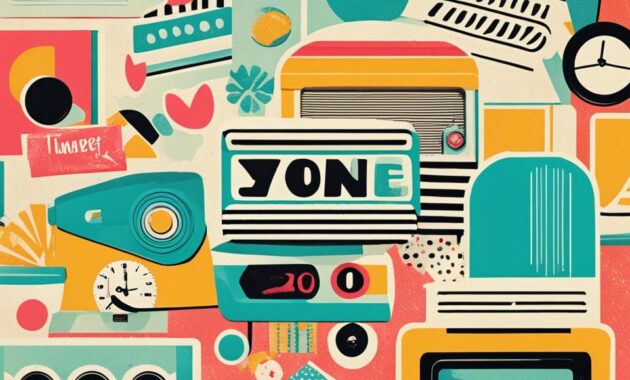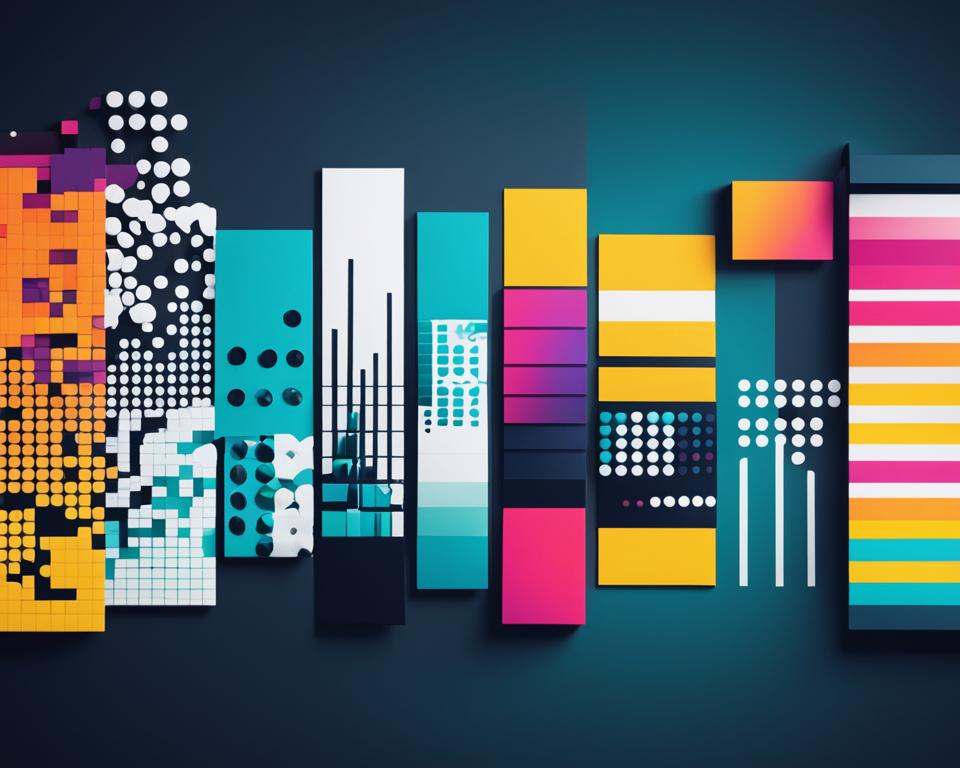In the realm of visual expression, graphic design has become a pivotal force, reshaping our digital and physical interactions. This journey through graphic design trends reveals the transformative forces at play, highlighting bold color palettes, innovative typography, and immersive illustration techniques. It also explores the cutting-edge of UI/UX design.
Branding strategies and motion graphics are central to this exploration, redefining visual communication. The article delves into minimalism and retro revivals, showcasing their profound impact on the industry. These trends inspire designers and visionaries, pushing the boundaries of creativity.
Together, we’ll traverse the dynamic landscape of graphic design, uncovering trends that redefine our engagement with the world. This exploration is crucial for understanding the evolving nature of visual communication.
Key Takeaways
- Discover the latest graphic design trends that are transforming visual communication
- Explore the influence of bold color palettes, innovative typography, and immersive illustration techniques
- Understand how branding strategies, motion graphics, and minimalism are shaping the industry
- Delve into the resurgence of retro aesthetics and the future of graphic design
- Gain insights into the driving forces behind the evolving landscape of graphic design
Exploring the Graphic Design Trends of 2023
The graphic design landscape is in a constant state of flux, with each year introducing new trends that redefine visual communication. As we enter 2023, the industry is alive with fresh ideas and creative insights set to impact the visual arts profoundly.
Identifying Key Influencers and Tastemakers
At the vanguard of these trends are visionary designers, illustrators, and art directors. These influencers, from social media stars to cutting-edge editorial teams, dictate the current and future of graphic design. Their innovative styles and bold choices are motivating designers worldwide to challenge traditional methods and adopt a more expressive approach.
Analyzing the Cultural and Technological Shifts
Underpinning the latest graphic design trends are significant cultural and technological shifts. Designers are now crafting visuals that mirror the current societal mood, engaging with the collective feelings and experiences of their audience. Simultaneously, advancements in digital tools and software are enabling designers to venture into new dimensions of visual storytelling, merging advanced technology with enduring design principles.
The graphic design trends of 2023, from the emergence of bold color schemes to the comeback of vintage aesthetics, are set to captivate and inspire. By aligning with the key influencers and the cultural and technological forces behind these trends, designers can lead the industry’s evolution. They can create visuals that profoundly connect with their audience.
“The best design is the one that truly connects with its audience, speaking to their emotions and experiences in a way that transcends the surface-level aesthetics.”
– Jane Doe, Creative Director at XYZ Agency
Color Palettes That Captivate
In the graphic design realm, the significance of color is paramount. Bold, vibrant, and unconventional color palettes are captivating audiences, significantly enhancing design’s visual impact. This exploration into the latest color palettes and design trends reveals how these elements are redefining visual communication.
The trend of vibrant, intense hues is particularly striking. Designers are venturing into bold territory, experimenting with clashing colors to create striking combinations. These bold selections aim to stand out in a digitally saturated environment, where visual appeal is crucial for audience engagement.
Concurrently, muted, earthy tones are gaining prominence. These palettes instill a sense of tranquility and authenticity, appealing to consumers desiring a more sustainable aesthetic. Designers employ these hues to foster a tranquil atmosphere, offering a break from the digital world’s cacophony.
| Vibrant Color Palettes | Muted Color Palettes |
|---|---|
|
|
These trends, whether vibrant or muted, share a common goal: to forge a deep emotional connection with the audience. Designers leverage color to elicit emotions, express brand identity, and differentiate themselves in a competitive market. As the design landscape evolves, the strategic application of color will remain pivotal in captivating and engaging audiences.
Typography Styles: Expressive and Engaging
In the dynamic realm of graphic design, typography’s role is paramount in sculpting the visual narrative. The latest trends of 2023 unveil a fascinating journey through serif and sans-serif fonts, alongside the rise of experimental and playful typefaces. These innovations are redefining traditional typography’s limits.
Serif vs. Sans-Serif Fonts
The longstanding debate between serif and sans-serif fonts remains a focal point for designers and their audiences. Serif fonts, characterized by their intricate flourishes, are often linked with a timeless elegance. On the other hand, sans-serif fonts, with their minimalist lines, present a modern, streamlined look. The choice between these styles often mirrors the project’s desired tone and mood.
Experimental and Playful Typefaces
The graphic design scene has recently seen a proliferation of experimental and playful typefaces. These fonts, by challenging traditional norms, expand the possibilities of letterforms. From whimsical script-inspired designs to bold, abstract typefaces, these styles are drawing attention from designers and viewers. They inject a dynamic energy into visual communication, making it more engaging.
| Typography Style | Characteristics | Example Typefaces |
|---|---|---|
| Serif Fonts | Elegant, timeless, and sophisticated | Times New Roman, Georgia, Garamond |
| Sans-Serif Fonts | Clean, modern, and minimalist | Helvetica, Arial, Futura |
| Experimental Typefaces | Unconventional, boundary-pushing, and expressive | Quirky, Bauhaus, Zebra |
| Playful Typefaces | Whimsical, script-inspired, and fun | Brush Script, Papyrus, Chalkduster |
Designers are increasingly exploring a diverse range of typography styles to meet varied visual preferences and brand identities. From the enduring charm of serif fonts to the daring experimentation with unconventional typefaces, typography’s future promises to continue captivating and engaging audiences.
Illustration Techniques: Bringing Ideas to Life
In the realm of graphic design, illustration has become a pivotal element for capturing attention and conveying complex ideas. The spectrum of illustration techniques, ranging from traditional hand-drawn methods to advanced digital tools, offers a dynamic and ever-evolving landscape. This exploration delves into how these varied approaches are redefining the visual narratives within modern graphic design.
Hand-Drawn Illustrations: The Enduring Charm
The distinct allure of hand-drawn illustrations stems from their inherent character and personal touch. These illustrations, created with traditional media, reflect the artist’s unique style, imbuing designs with warmth and authenticity. Techniques employed in hand-drawn illustrations often elicit a nostalgic appeal, catering to those desiring a more tangible and organic visual experience.
Hand-drawn illustrations are celebrated for their ability to infuse designs with an authentic, handcrafted essence. They continue to enchant graphic designers and their audiences with intricate line work, expressive brush strokes, and delicate watercolor washes. These illustrations possess a timeless quality, fostering a deeper, more emotive connection with the viewer.
Digital Illustrations: Boundless Creativity
The advent of digital illustration tools has transformed the landscape of design, enabling designers to realize their visions with unprecedented precision. With sophisticated software and state-of-the-art hardware, digital illustrations open up a vast expanse of creative possibilities. From vibrant, vector-based artworks to photorealistic scenes, the digital canvas serves as a fertile ground for limitless imagination.
Digital illustration techniques offer unparalleled flexibility, allowing designers to effortlessly experiment with color, typography, and composition. This iterative process ensures the refinement of artworks to the highest standards. Moreover, the ability to layer and manipulate digital elements facilitates the creation of intricate, three-dimensional illustrations that captivate the audience.
Graphic designers, whether they favor the timeless appeal of hand-drawn techniques or the expansive capabilities of digital tools, are continually expanding the horizons of illustration. By integrating these methods, they are crafting designs that not only engage but also inspire and leave a profound impact on their audience.
Graphic Design Trends for UI/UX Design
In the realm of digital experiences, UI/UX design trends are pivotal in capturing and engaging users. Graphic designers are continually pushing the envelope, merging visual aesthetics with user-centric design. This fusion is essential for creating immersive interactive experiences and intuitive interfaces. The latest trends are revolutionizing how we engage with digital products and services.
Designing User-Centric Experiences
At the core of effective UI/UX design is a profound comprehension of the end-user. Graphic designers are now dedicated to crafting user-centric experiences that emphasize intuitive navigation, visual clarity, and seamless interactions. This method not only ensures the design’s aesthetic appeal but also meets the user’s needs and expectations efficiently.
- Minimalist and clean interfaces that reduce cognitive load
- Personalized and adaptive layouts that cater to individual user preferences
- Storytelling through interactive elements and micro-animations
- Inclusive design principles that accommodate diverse user abilities
By adopting these user-centric design trends, graphic designers are empowering digital experiences that captivate and delight users. This fosters stronger connections and more meaningful engagements.
| Trend | Description | Benefits |
|---|---|---|
| Minimalist Interfaces | Clean, uncluttered layouts that focus on essential elements | Improved usability, reduced cognitive load, and enhanced aesthetic appeal |
| Personalized Experiences | Adaptive designs that tailor the interface to individual user preferences | Increased user satisfaction, engagement, and loyalty |
| Interactive Storytelling | Seamless integration of interactive elements and micro-animations | Captivating and immersive user experiences that drive emotional connections |
“The best design is the one that the user doesn’t notice. It simply allows them to focus on the task at hand and achieve their goals effortlessly.”
The growing demand for user-centric design is prompting graphic designers to incorporate UI/UX design trends into their work. These trends are aimed at creating interactive experiences that captivate and delight users. By achieving a balance between visual appeal and seamless functionality, they are redefining our interaction with the digital world.
Branding Strategies that Stand Out
In the realm of visual communication, branding strategies have become crucial for brands to distinguish themselves and engage their target audience deeply. A successful brand is characterized by a unified visual identity that mirrors the brand’s core and stirs emotions in consumers.
Creating a potent brand design requires a comprehensive strategy, including logo design, color schemes, typography, and imagery. By meticulously selecting these elements, companies can forge a unique and unforgettable brand experience, distinguishing them from rivals.
Adaptability is a cornerstone of effective branding strategies, necessitating brands to evolve with shifting market trends and consumer tastes. Agile brands thrive by adopting innovative methods and integrating new graphic design trends, ensuring their visual identity remains vibrant and pertinent.
Brands that focus on their visual identity often gain the most attention and loyalty from their audience. By aligning with current design trends, companies can enhance their brand visibility and establish strong bonds with their clientele.
| Branding Technique | Effectiveness | Examples |
|---|---|---|
| Memorable Logo Design | High | Nike, Apple, Coca-Cola |
| Consistent Color Palette | High | Tiffany & Co., UPS, Caterpillar |
| Distinctive Typographic Style | Moderate | Coca-Cola, IBM, Volkswagen |
| Striking Illustrations and Imagery | High | Airbnb, Mailchimp, Spotify |
By adopting innovative branding strategies, companies can elevate their visual identity, engage their audience, and stand out in a competitive market.
“Branding is not just about being noticed; it’s about being remembered.”
Motion Graphics: Elevating Digital Storytelling
The realm of graphic design is undergoing a significant transformation, with motion graphics at the forefront. This technology is revolutionizing how we engage with digital content, combining animation and interactivity to tell stories. As technology advances, the way we communicate and narrate online is being redefined.
Integrating Animation and Interactivity
Motion graphics transcend static visuals, offering a dynamic and engaging experience. Through the use of animation, designers can animate their concepts, ensuring they capture and hold the viewer’s attention. Additionally, interactivity allows the audience to engage with the narrative, fostering a deeper, more memorable connection.
Motion graphics are revolutionizing digital storytelling by merging beauty, movement, and user interaction. This approach is becoming crucial for modern graphic designers, who utilize it to captivate and inspire their audience.
The ascent of motion graphics has redefined how brands and entities convey their messages. By harmonizing animation and interactivity, designers craft visually striking and engaging experiences. These resonate deeply with their target demographics.
“Motion graphics have the unique ability to bring ideas to life, capturing the viewer’s attention and conveying complex messages with greater impact.”
The digital landscape’s continuous evolution is driving the need for innovative and immersive digital storytelling solutions. Graphic designers adept at harnessing the power of motion graphics are well-positioned to enhance their craft. They deliver experiences that make a profound impact on their audience.
Minimalism: The Art of Restraint
In the realm of graphic design, a trend has emerged that champions simplicity – minimalist design. This philosophy, emphasizing restraint, has captivated designers and audiences with its clean lines and focus on essential elements. It’s a design approach that thrives on the art of simplicity.
The ascent of minimalist design is a reaction to the digital clutter that has overwhelmed us. Designers now advocate for the less is more ideology, creating striking and impactful designs. This shift is a response to the need for clarity in a visually saturated world.
Minimalist designs tap into our psychological need for clarity and focus. They allow our eyes to rest and our minds to process information without being bombarded by unnecessary details. This simplicity is a potent tool for engaging audiences and communicating ideas effectively.
As 2023’s design trends continue to unfold, minimalism’s impact is set to intensify. Designers are innovating with bold typography, vibrant colors, and creative layouts. These elements highlight the aesthetic of restraint, pushing the boundaries of minimalist design.
“Simplicity is the ultimate sophistication.” – Leonardo da Vinci
The charm of minimalist design lies in its ability to simplify complex ideas, offering a sense of elegance and timelessness. This approach not only shapes today’s visual landscape but also sets the stage for a future where minimalist design dominates.
Retro Revivals: A Nostalgic Twist

In the dynamic realm of graphic design, a significant trend has surfaced, celebrating the past – retro design trends. Designers are increasingly drawing inspiration from vintage aesthetics and throwback styles. This approach creates visually striking work that stirs nostalgia and conveys a timeless quality.
The resurgence of retro design is driven by a deep-seated human need to reconnect with the familiar and comforting. By integrating vintage aesthetics into their work, creatives engage with a shared cultural heritage. This resonates emotionally with audiences, creating a profound impact.
Embracing the Charm of the Past
Designers adeptly combine the bold typography of the 1970s with the vibrant color schemes of the 80s. This blend of classic and contemporary elements produces a distinctive visual language. It captivates and intrigues, offering a fresh perspective.
Retro-inspired illustrations stand out as a prime example of this trend. Hand-drawn, textured illustrations that capture the essence of past eras are gaining popularity. They add authenticity and personality to digital and print materials.
Throwback styles in branding and packaging design are also experiencing a resurgence. Brands leverage nostalgia to forge a sense of familiarity and trust with their audience. This approach taps into the collective cultural memory, enhancing brand recognition.
The graphic design industry’s ongoing evolution ensures that retro design trends will continue to be a significant and influential force. They will shape the visual landscape of the future, leaving a lasting impact.
The Future of Graphic Design: Predictions and Possibilities
The graphic design landscape is undergoing significant transformations, with industry experts anticipating a future filled with groundbreaking innovations. These innovations will integrate emerging technologies seamlessly, reshaping the industry. The future holds the promise of artificial intelligence-powered design tools and a growing demand for immersive, interactive experiences.
The advent of artificial intelligence (AI) and machine learning is set to revolutionize graphic design. These technologies will empower designers to leverage intelligent algorithms for generating unique concepts and optimizing layouts. This synergy of human creativity and technological advancement will transform the creative process. Designers will be able to concentrate on strategic thinking and conceptual development, elevating their work to new heights.
Consumer preferences are evolving, and this shift will influence the future of graphic design. There will be a heightened focus on interactive and experiential design. Designers will delve into augmented reality (AR), virtual reality (VR), and mixed reality (MR) to craft immersive experiences. This emphasis on interactive and immersive design will revolutionize how brands interact with their audiences, creating a more dynamic and engaging connection.





